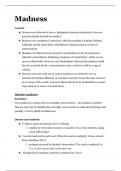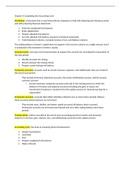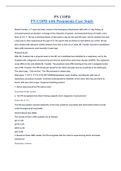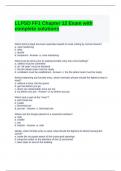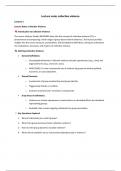CONSUMER MARKETING
Lecture 1: Consumer Behaviour
= is the totality of decisions about the consumptions of an offering by decision-making units over time.
Much more than the purchase itself.
The totality of decisions Whether, what, why, how, when, where, how much/often/long
About the consumptions Acquisition – Usage – Disposition
On an offering Products, services, activities & experiences, people, ideas
By decision-making units Information gatherer, influencer, decider, purchaser, user
Over time Hours, days, weeks, months, years
It looks at what consumers think, feel and do. The judgements, product evaluations and decisions and
especially the underlying psychological mechanisms. Each stage could be influenced by marketing
tactics & strategies.
The WISE Framework
WATCH
Awareness – Evaluation – Choice – Consumption – Post-Consumption
Interest –
Internal Social External
Motivation Social comparison Marketing Mix (product,
price,
Perception Social norms place, promotion)
Needs & wants Social motives Physical surroundings
Emotions Similarity (we like similar Market influences
(Economic
Beliefs, attitudes, values more), likeability cycles)
Judgement Familiarity (mere- Context effects (time of the
exposure
Subconscious and non- effect) day, surrounding products)
conscious influences Reciprocity Choice architecture
(nudging)
Information processing Conformity Trends
Learning and memory Authority (clothing,
looks,
Identity, the self titles, affiliations, power)
,For every decision-making stage ask 5 Ws as prompts:
● Who is the consumer
● What internal, social, external factors influence the consumer? What interactions
does that consumer have?
● When does the consumer make the purchasing decision, and what’s going on before
purchasing, during, and after that decision?
● Where are consumers making decisions? (e.g., home, store, online; may
depend on the decision-making stage)
● Why? Aimless examination of consumer behavior can be dangerous
Motivation
Model of Consumer Motivation
1. Needs: desires that arise when a consumer’s actual state does not meet his or
her desired state
● Physiological Needs—innate or primary
● Psychological Needs—secondary
2. Wants: learned manifestation of needs
● Product-specific needs
3. Motivation: A driving force that moves
or incites consumers to act
● Motivation focuses attention
on goal- relevant objects.
● Need: negatively originated motivation
, ● Want: positively originated motivation
Lecture 3: Advertising
Gist = finding out what an ad is about at a single glance.
= the essential meaning of a scene in terms of the categories it belongs to serves as an early
categorization process in cluttered environments, determining which scenes or objects are
interesting enough to pay more attention to.
Levels of ad gist:
1. Advertisement or editorial content?
2. Which product category?
3. Which brand?
4. Is it interesting to you?
Article 1:
Elsen, M., R. Pieters and M. Wedel (2016), “Thin Slice Impressions: How Advertising Evaluation
Depends on Exposure Duration,” Journal of Marketing Research
Article: Elsen, M., R. Pieters and M. Wedel (2016), “Thin Slice Impressions: How Advertising
Evaluation Depends on Exposure Duration”
WATCH: Awareness, Interest (Ad attitude, brand attitude)
INTERNAL: SOCIAL: EXTERNAL:
Perception Ad types (mystery, upfront,
Information processing false front)
Ad identification Time (exposure duration,
time
Feeling of knowing pressure)
1. Aim of the article
The aim of the article is to demonstrate the importance of thin slices of information in ad
and brand evaluation with implications for advertising research and management.
, 2. Introduction and Context
● Consumers are confronted with thousands of advertisements and consumers
generally watch advertisements only shortly (< 2 s) - “Thin slices of information”
● People tend to rapidly categorize the stimuli in their environment – also when
determining which identity an ad has.
● What do we learn about the basic identity of the ad (the promoted product and
brand) in a short time span? How does it influence ad (and brand) evaluation?
The research looks at three common ways in which ads convey their basic identity:
1 - UPFRONT ADS
● Instantly convey what they promote. (Shows you what the ad is about and in a flash you know
what it is all about.)
● Typical for the product category they advertise.
● Similar to other ads in the same category and dissimilar from ads in other categories.
2 - FALSE FRONT ADS
● Initially convey another identity than what they promote. (Misleads the consumer, making them
think it belongs to another product category)
● Atypical for the product category they advertise
● Dissimilar from other ads in the same category and similar from ads in other categories
3 - MYSTERY ADS
● Suspend conveying what they promote. (Consumers does not instantly comprehend the brand or
product being promoted, they feel the need to spend more time to understand)
● The ads contain indirect or delayed signals of their true identity.
● Atypical for the product category they advertise
● Dissimilar from other ads in the same category and dissimilar from ads in other categories
(Whereas upfront ads make themselves instantly known, mystery and false front ads postpone
disclosing their true identity, although they do so in different ways.)
Lecture 1: Consumer Behaviour
= is the totality of decisions about the consumptions of an offering by decision-making units over time.
Much more than the purchase itself.
The totality of decisions Whether, what, why, how, when, where, how much/often/long
About the consumptions Acquisition – Usage – Disposition
On an offering Products, services, activities & experiences, people, ideas
By decision-making units Information gatherer, influencer, decider, purchaser, user
Over time Hours, days, weeks, months, years
It looks at what consumers think, feel and do. The judgements, product evaluations and decisions and
especially the underlying psychological mechanisms. Each stage could be influenced by marketing
tactics & strategies.
The WISE Framework
WATCH
Awareness – Evaluation – Choice – Consumption – Post-Consumption
Interest –
Internal Social External
Motivation Social comparison Marketing Mix (product,
price,
Perception Social norms place, promotion)
Needs & wants Social motives Physical surroundings
Emotions Similarity (we like similar Market influences
(Economic
Beliefs, attitudes, values more), likeability cycles)
Judgement Familiarity (mere- Context effects (time of the
exposure
Subconscious and non- effect) day, surrounding products)
conscious influences Reciprocity Choice architecture
(nudging)
Information processing Conformity Trends
Learning and memory Authority (clothing,
looks,
Identity, the self titles, affiliations, power)
,For every decision-making stage ask 5 Ws as prompts:
● Who is the consumer
● What internal, social, external factors influence the consumer? What interactions
does that consumer have?
● When does the consumer make the purchasing decision, and what’s going on before
purchasing, during, and after that decision?
● Where are consumers making decisions? (e.g., home, store, online; may
depend on the decision-making stage)
● Why? Aimless examination of consumer behavior can be dangerous
Motivation
Model of Consumer Motivation
1. Needs: desires that arise when a consumer’s actual state does not meet his or
her desired state
● Physiological Needs—innate or primary
● Psychological Needs—secondary
2. Wants: learned manifestation of needs
● Product-specific needs
3. Motivation: A driving force that moves
or incites consumers to act
● Motivation focuses attention
on goal- relevant objects.
● Need: negatively originated motivation
, ● Want: positively originated motivation
Lecture 3: Advertising
Gist = finding out what an ad is about at a single glance.
= the essential meaning of a scene in terms of the categories it belongs to serves as an early
categorization process in cluttered environments, determining which scenes or objects are
interesting enough to pay more attention to.
Levels of ad gist:
1. Advertisement or editorial content?
2. Which product category?
3. Which brand?
4. Is it interesting to you?
Article 1:
Elsen, M., R. Pieters and M. Wedel (2016), “Thin Slice Impressions: How Advertising Evaluation
Depends on Exposure Duration,” Journal of Marketing Research
Article: Elsen, M., R. Pieters and M. Wedel (2016), “Thin Slice Impressions: How Advertising
Evaluation Depends on Exposure Duration”
WATCH: Awareness, Interest (Ad attitude, brand attitude)
INTERNAL: SOCIAL: EXTERNAL:
Perception Ad types (mystery, upfront,
Information processing false front)
Ad identification Time (exposure duration,
time
Feeling of knowing pressure)
1. Aim of the article
The aim of the article is to demonstrate the importance of thin slices of information in ad
and brand evaluation with implications for advertising research and management.
, 2. Introduction and Context
● Consumers are confronted with thousands of advertisements and consumers
generally watch advertisements only shortly (< 2 s) - “Thin slices of information”
● People tend to rapidly categorize the stimuli in their environment – also when
determining which identity an ad has.
● What do we learn about the basic identity of the ad (the promoted product and
brand) in a short time span? How does it influence ad (and brand) evaluation?
The research looks at three common ways in which ads convey their basic identity:
1 - UPFRONT ADS
● Instantly convey what they promote. (Shows you what the ad is about and in a flash you know
what it is all about.)
● Typical for the product category they advertise.
● Similar to other ads in the same category and dissimilar from ads in other categories.
2 - FALSE FRONT ADS
● Initially convey another identity than what they promote. (Misleads the consumer, making them
think it belongs to another product category)
● Atypical for the product category they advertise
● Dissimilar from other ads in the same category and similar from ads in other categories
3 - MYSTERY ADS
● Suspend conveying what they promote. (Consumers does not instantly comprehend the brand or
product being promoted, they feel the need to spend more time to understand)
● The ads contain indirect or delayed signals of their true identity.
● Atypical for the product category they advertise
● Dissimilar from other ads in the same category and dissimilar from ads in other categories
(Whereas upfront ads make themselves instantly known, mystery and false front ads postpone
disclosing their true identity, although they do so in different ways.)

